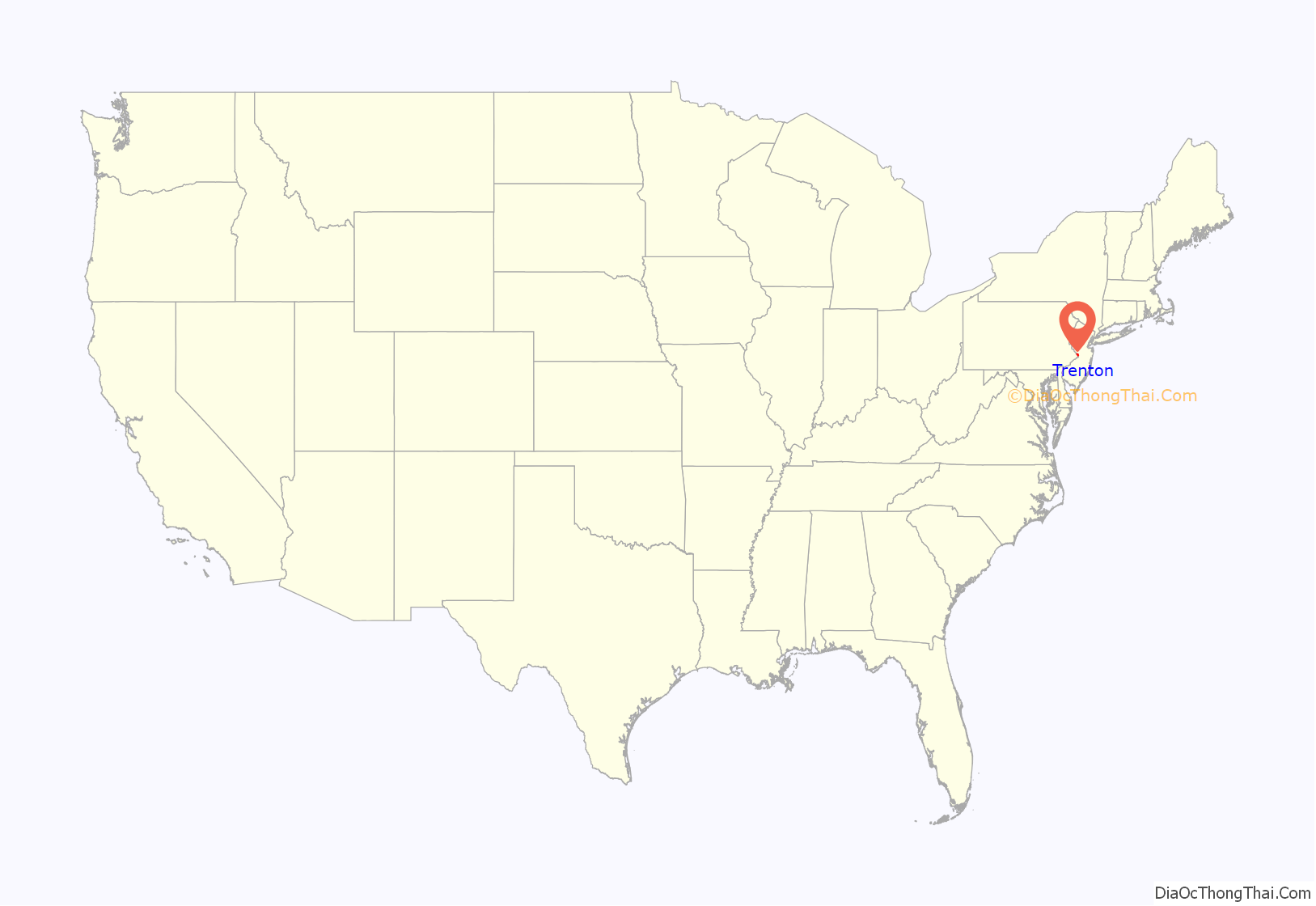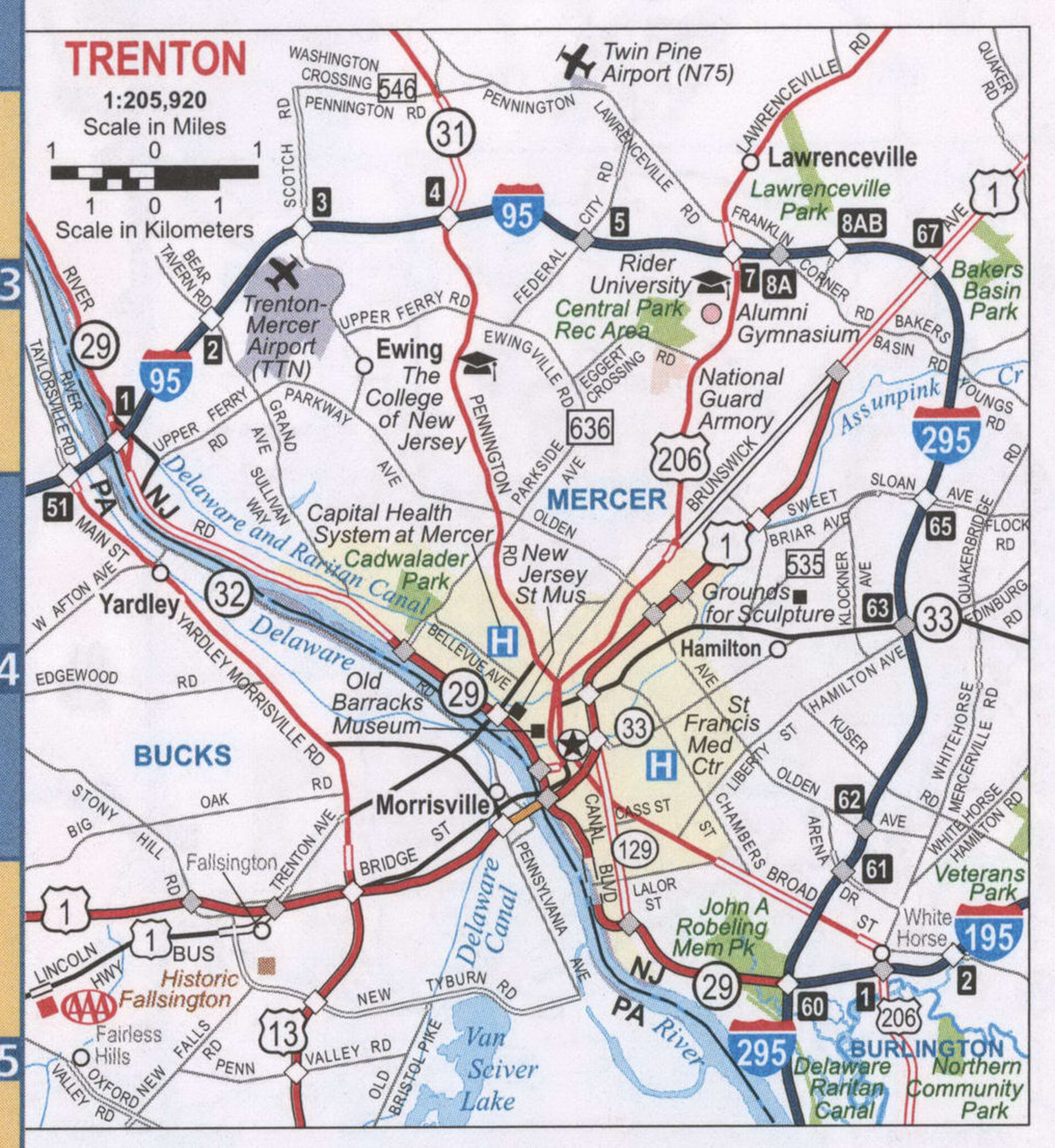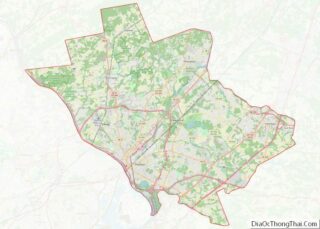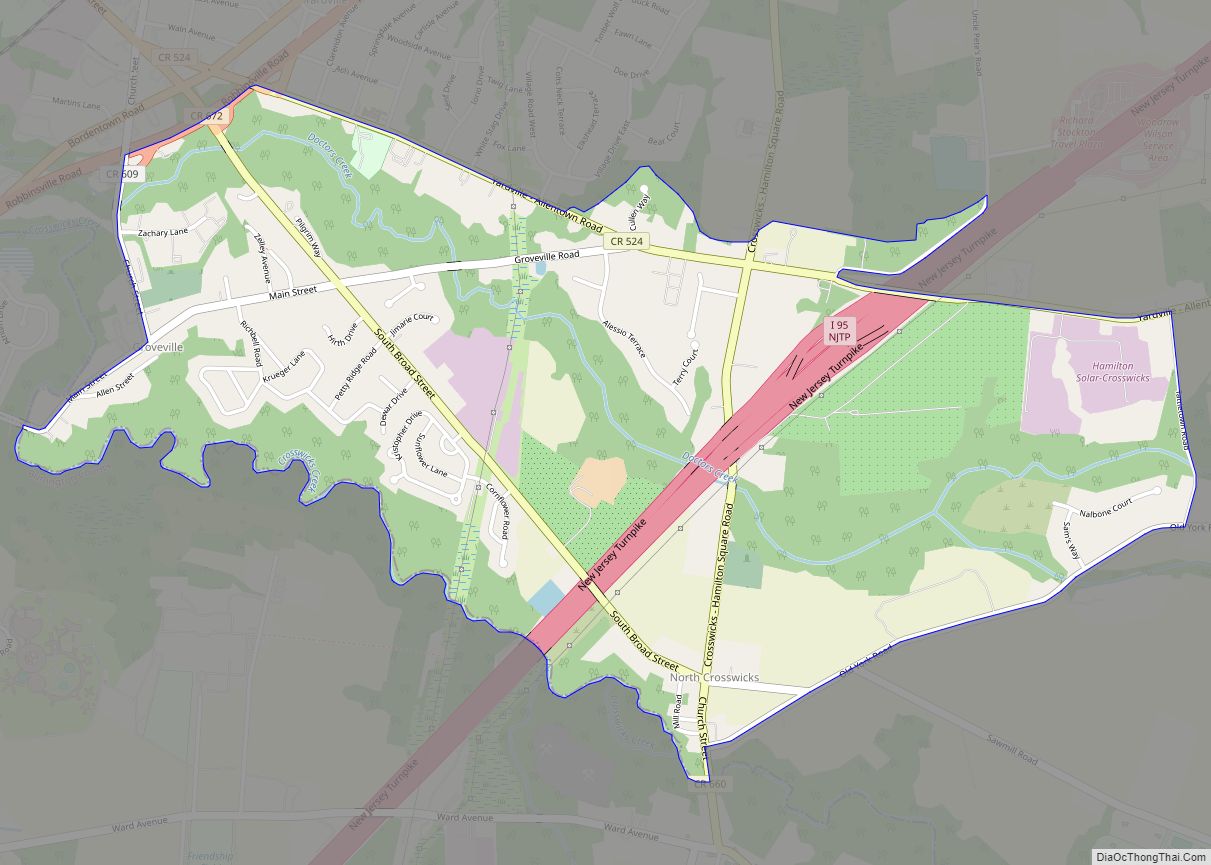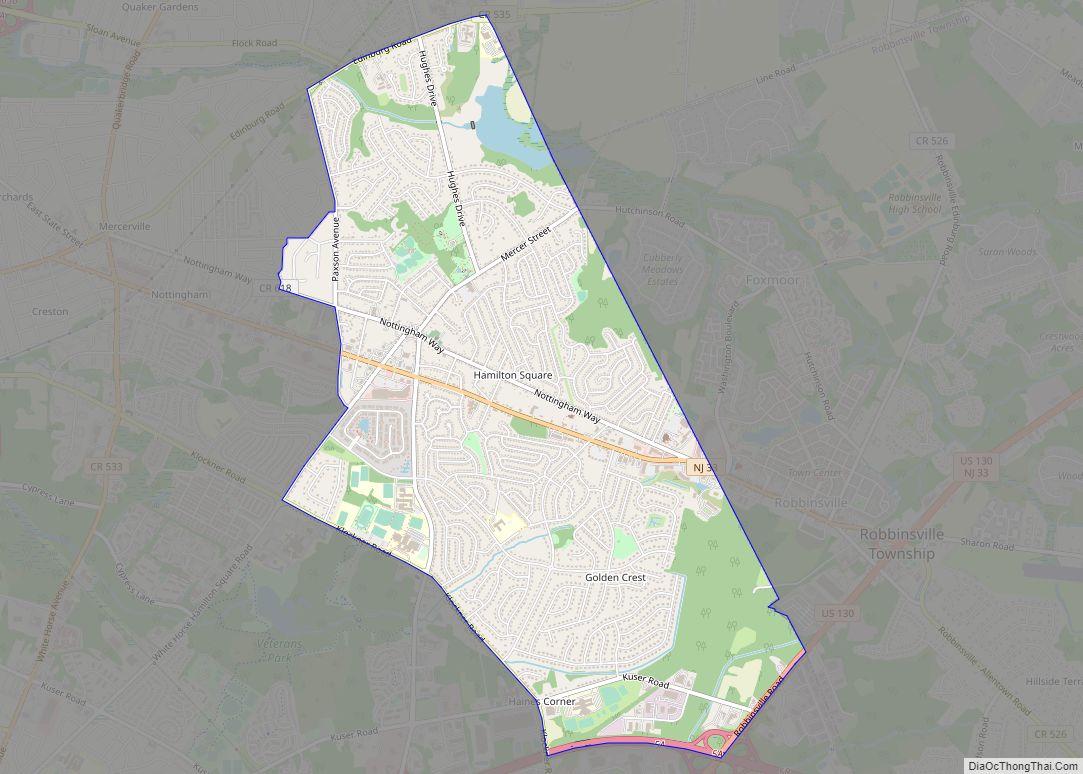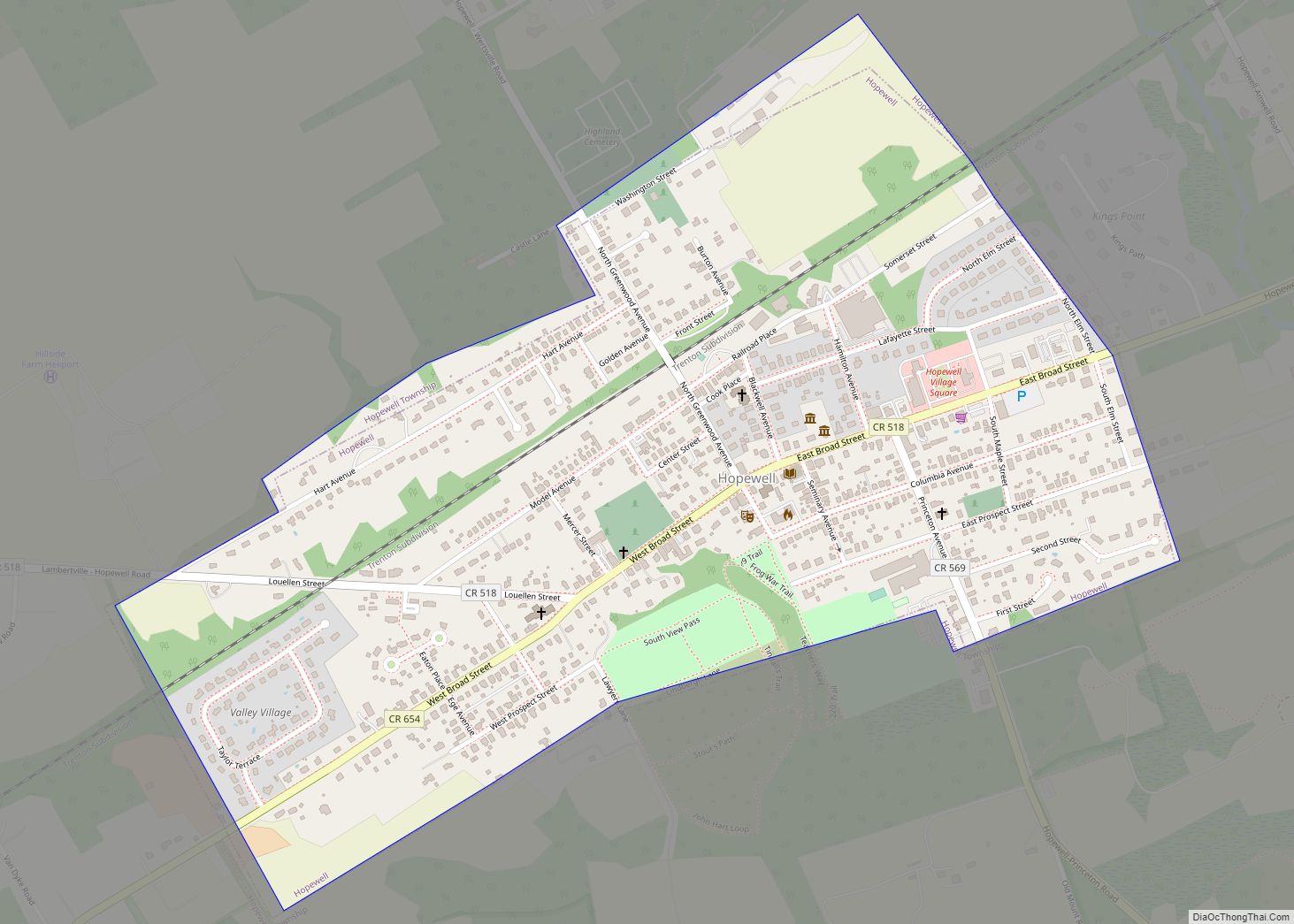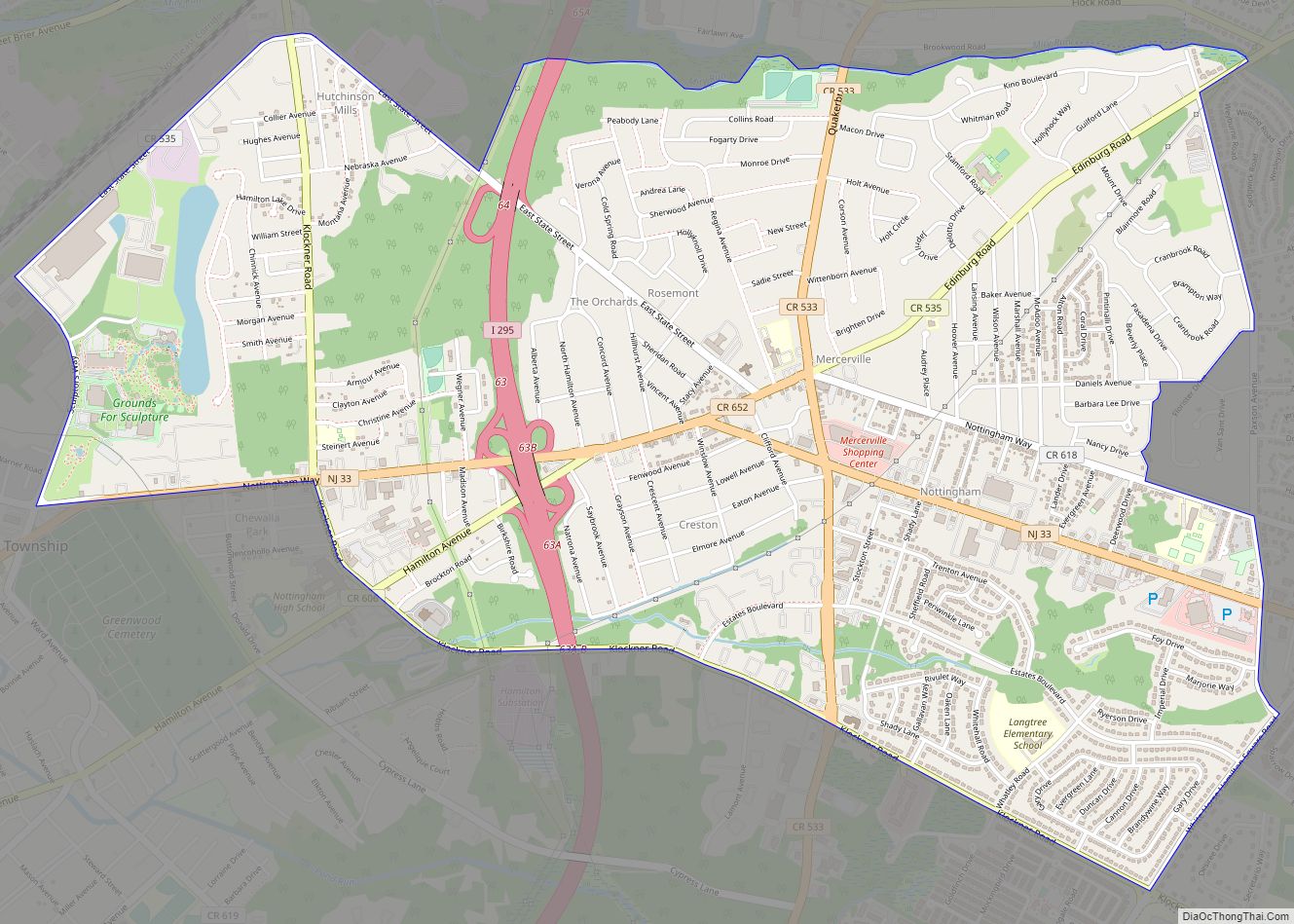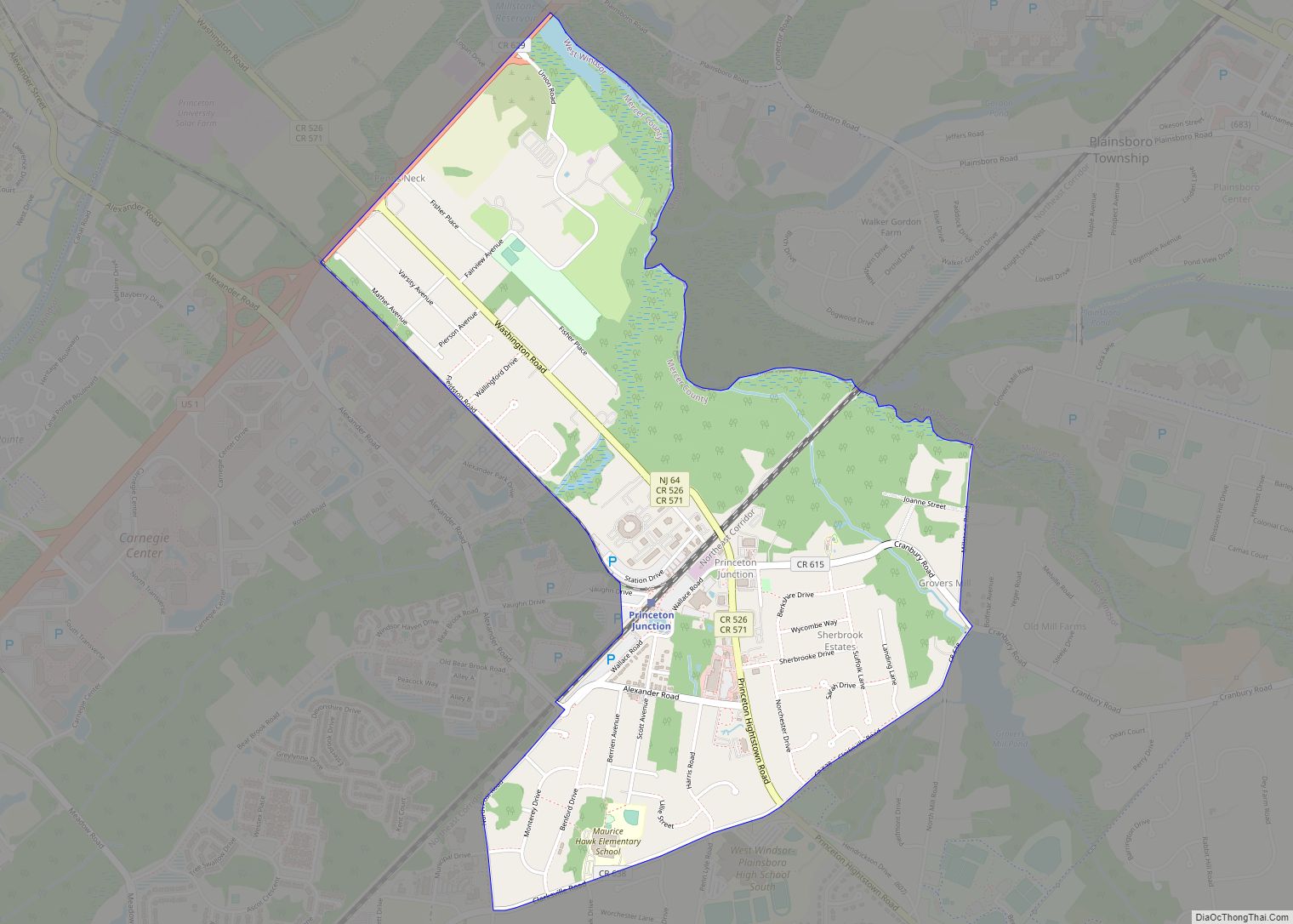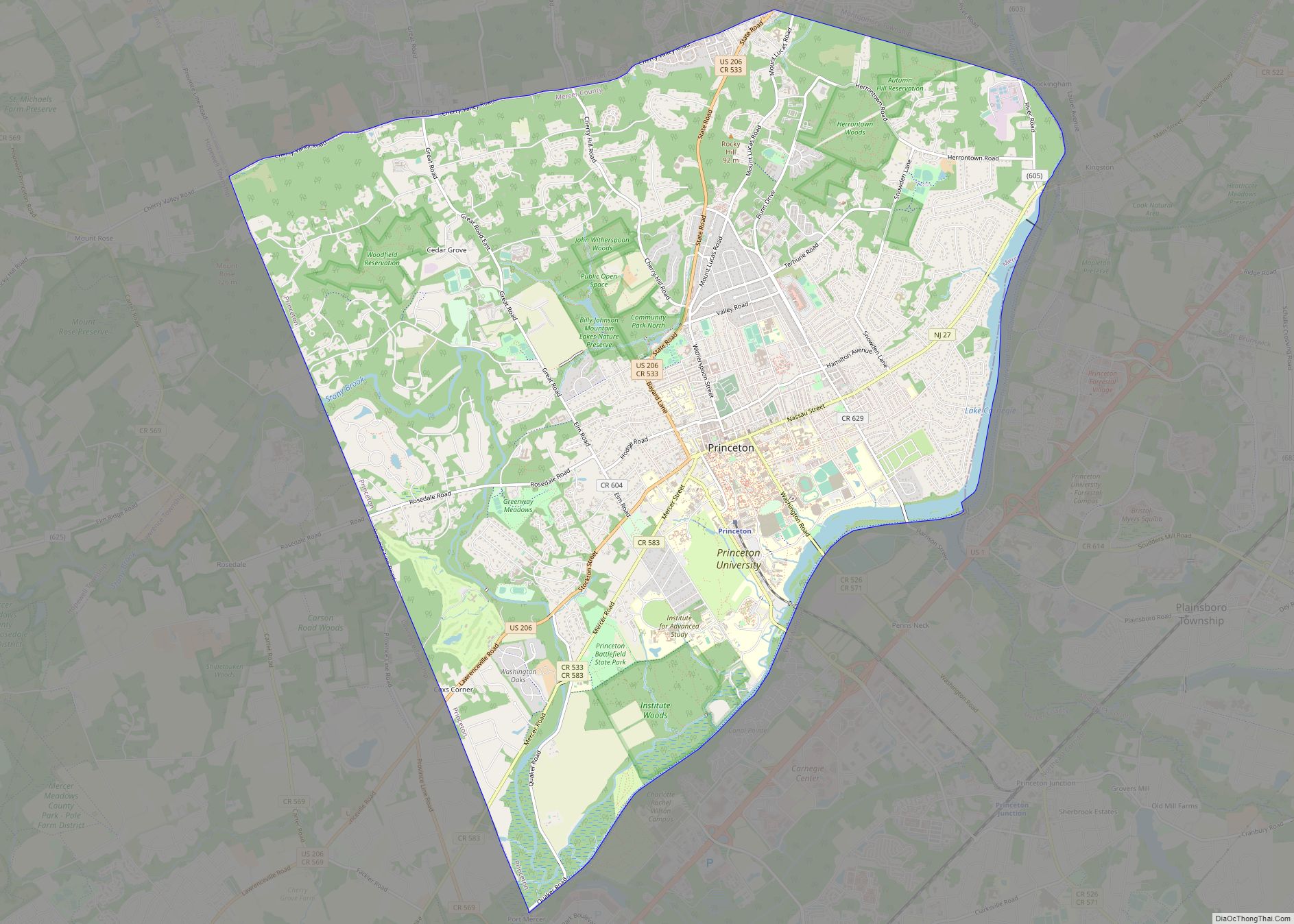Trenton is the capital city of the U.S. state of New Jersey and the seat of Mercer County. It was the capital of the United States from November 1 to December 24, 1784. Trenton and Princeton are the two principal cities of the Trenton–Princeton metropolitan statistical area, which encompasses those cities and all of Mercer County for statistical purposes and constitutes part of the New York combined statistical area by the U.S. Census Bureau. However, Trenton directly borders the Philadelphia metropolitan area to its west, and the city was part of the Philadelphia combined statistical area from 1990 until 2000.
As of the 2020 United States census, Trenton was the state’s 10th-most-populous municipality, with a population of 90,871, an increase of 5,958 (+7.0%) from the 2010 census count of 84,913, which in turn had reflected a decline of 490 (−0.6%) from the 85,403 counted at the 2000 census. The Census Bureau’s Population Estimates Program calculated that the city’s population was 90,457 in 2021, ranking the city the 378th-most-populous in the country. Trenton is the only city in New Jersey that serves three separate commuter rail transit systems (Amtrak, NJ Transit, and SEPTA), and the city has encouraged a spate of transit-oriented development since 2010.
Trenton dates back at least to June 3, 1719, when mention was made of a constable being appointed for Trenton while the area was still part of Hunterdon County. Boundaries were recorded for Trenton Township as of March 2, 1720. A courthouse and jail were constructed in Trenton around 1720, and the Freeholders of Hunterdon County met annually in Trenton.
Abraham Hunt was appointed in 1764 as Trenton’s first Postmaster. On November 25, 1790, Trenton became New Jersey’s capital, and by November 13, 1792 the City of Trenton was formed within Trenton Township. Trenton Township was incorporated as one of New Jersey’s initial group of 104 townships by an act of the New Jersey Legislature on February 21, 1798. On February 22, 1834, portions of Trenton Township were taken to form Ewing Township. The remaining portion of Trenton Township was absorbed by the city on April 10, 1837. A series of annexations took place over a 50-year period with the city absorbing South Trenton (April 14, 1851), portions of Nottingham Township (April 14, 1856), Chambersburg Township and Millham Township (both on March 30, 1888), and Wilbur (February 28, 1898). Portions of Ewing Township and Hamilton Township were annexed to Trenton on March 23, 1900.
| Name: | Trenton city |
|---|---|
| LSAD Code: | 25 |
| LSAD Description: | city (suffix) |
| State: | New Jersey |
| County: | Mercer County |
| Founded: | June 3, 1719 |
| Incorporated: | November 13, 1792 |
| Elevation: | 59 ft (18 m) |
| Land Area: | 7.61 sq mi (19.70 km²) |
| Water Area: | 0.60 sq mi (1.55 km²) 7.62% |
| Population Density: | 11,989.8/sq mi (4,629.3/km²) |
| Area code: | 609 |
| FIPS code: | 3474000 |
| GNISfeature ID: | 0885421 |
| Website: | www.trentonnj.org |
Online Interactive Map
Click on ![]() to view map in "full screen" mode.
to view map in "full screen" mode.
Trenton location map. Where is Trenton city?
History
The earliest known inhabitants of the area that is today Trenton were the Lenape Native Americans. The first European settlement in what would become Trenton was established by Quakers in 1679, in the region then called the Falls of the Delaware, led by Mahlon Stacy from Handsworth, Sheffield, England. Quakers were being persecuted in England at this time, and North America provided an opportunity to exercise their religious freedom.
By 1719, the town adopted the name “Trent-towne”, after William Trent, one of its leading landholders who purchased much of the surrounding land from Stacy’s family. This name was later shortened to “Trenton”.
On January 19, 1764, Benjamin Franklin, Postmaster General of the colonies, appointed Abraham Hunt, a Lieutenant Colonel in the New Jersey Hunterdon County militia and prominent merchant in Trenton, as the city’s first postmaster. Hunt was again appointed Trenton’s postmaster on October 13, 1775, shortly after the American Revolutionary War broke out.
During the American Revolutionary War, Trenton was the site of the Battle of Trenton, George Washington’s first military victory. On December 25–26, 1776, Washington and his army, crossed the icy Delaware River to Trenton, where they defeated Hessian troops garrisoned there. The second battle of Trenton, Battle of the Assunpink Creek, was fought here on January 2, 1777. After the war, the Congress of the Confederation met for two months at the French Arms Tavern from November 1, 1784, to December 24, 1784. While the city was preferred by New England and other northern states as a permanent capital for the new country, the southern states ultimately prevailed in their choice of a location south of the Mason–Dixon line. On April 21, 1789, the city hosted a reception for George Washington on his journey to New York City for his first inauguration.
Trenton became the state capital in 1790, but prior to that year the New Jersey Legislature often met in the city. The city was incorporated in 1792. In 1799, the federal government relocated its offices to Trenton for a period of several months, following an outbreak of yellow fever in the then-capital of Philadelphia.
During the War of 1812, the United States Army’s primary hospital was at a site on Broad Street.
Throughout the 19th century, Trenton grew steadily, as European immigrants came to work in its pottery and wire rope mills. In 1837, with the population now too large for government by council, a new mayoral government was adopted, with by-laws that remain in operation to this day.
The Trenton Six were a group of black men arrested for the alleged murder of an elderly white shopkeeper in January 1948 with a soda bottle. They were arrested without warrants, denied lawyers and sentenced to death based on what were described as coerced confessions. With the involvement of the Communist Party and the NAACP, there were several appeals, resulting in a total of four trials. Eventually the accused men (with the exception of one who died in prison) were released. The incident was the subject of the book Jersey Justice: The Story of the Trenton Six, written by Cathy Knepper.
Riots of 1968
The Trenton Riots of 1968 were a major civil disturbance that took place during the week following the assassination of civil rights leader Martin Luther King Jr. in Memphis on April 4. Race riots broke out nationwide following the murder of the civil rights activist. More than 200 Trenton businesses, mostly in Downtown, were ransacked and burned. More than 300 people, most of them young black men, were arrested on charges ranging from assault and arson to looting and violating the mayor’s emergency curfew. In addition to 16 injured policemen, 15 firefighters were treated at city hospitals for injuries suffered while fighting raging blazes or inflicted by rioters. Area residents pulled false alarms and would then throw bricks at firefighters responding to the alarm boxes. This experience, along with similar experiences in other major cities, effectively ended the use of open-cab fire engines. As an interim measure, the Trenton Fire Department fabricated temporary cab enclosures from steel deck plating until new equipment could be obtained. The losses incurred by downtown businesses were initially estimated by the city to be $7 million, but the total of insurance claims and settlements came to $2.5 million.
Trenton’s Battle Monument neighborhood was hardest hit. Since the 1950s, North Trenton had witnessed a steady exodus of middle-class residents, and the riots spelled the end for North Trenton. By the 1970s, the region had become one of the most blighted and crime-ridden in the city.
Trenton Road Map
Trenton city Satellite Map
Geography
According to the U.S. Census Bureau, the city had a total area of 8.21 square miles (21.25 km), including 7.58 square miles (19.63 km) of land and 0.63 square miles (1.62 km) of water (7.62%).
Several bridges across the Delaware River connect Trenton to Morrisville, Pennsylvania, all of which are operated by the Delaware River Joint Toll Bridge Commission. The Trenton–Morrisville Toll Bridge, originally constructed in 1952, stretches 1,324 feet (404 m), carrying U.S. Route 1. The Lower Trenton Bridge, bearing the legend “Trenton Makes The World Takes Bridge”, is a 1,022-foot (312 m) span that was constructed in 1928 on the site of a bridge that dates back to 1804. The Calhoun Street Bridge, dating back to 1884, is 1,274 feet (388 m) long.
Trenton is located near the geographic center of the state, which is located 5 miles (8.0 km) southeast of the city. The city is sometimes included as part of North Jersey and as the southernmost city of the Tri-State Region, while others consider it a part of South Jersey and thus, the northernmost city of the Delaware Valley.
However, Mercer County constitutes its own metropolitan statistical area, the Trenton-Princeton MSA. Locals consider Trenton to be a part of an ambiguous area known as Central Jersey, and thus part of neither region. They are generally split as to whether they are within New York or Philadelphia’s sphere of influence. While it is geographically closer to Philadelphia, many people who have recently moved to the area commute to New York City, and have moved there to escape the New York region’s high housing costs.
Trenton is one of two state capitals that border another state—the other being Carson City, Nevada. It is also one of the seven state capitals located within the Piedmont Plateau.
Trenton borders Ewing Township, Hamilton Township and Lawrence Township in Mercer County; and Falls Township, Lower Makefield Township and Morrisville in Bucks County, Pennsylvania, across the Delaware River in Pennsylvania.
The Northeast Corridor goes through Trenton. A straight line drawn between Center City, Philadelphia and Downtown Manhattan would pass within 2000 feet of the New Jersey State House.
Neighborhoods
Trenton is home to numerous neighborhoods and sub-neighborhoods. The main neighborhoods are taken from the four cardinal directions (North, South, East, and West). Trenton was once home to large Italian, Hungarian, and Jewish communities, but, since the 1950s, demographic shifts have changed the city into a relatively segregated urban enclave of middle and lower income African Americans and newer immigrants, many of whom arrive from Latin America. Italians are scattered throughout the city, but a distinct Italian community is centered in the Chambersburg neighborhood, in South Trenton. This community has been in decline since the 1970s, largely due to economic and social shifts to the suburbs surrounding the city. Today Chambersburg has a large Latino community. Many of the Latino immigrants are from Mexico, Guatemala and Nicaragua. There is also a significant and growing Asian community in the Chambersburg neighborhood primarily made up of Burmese and Bhutanese/Nepali refugees.
The North Ward, once a mecca for the city’s middle class, is now one of the most economically distressed, torn apart by race riots following the assassination of Martin Luther King Jr. in 1968. Nonetheless, the area still retains many important architectural and historic sites. North Trenton still has a large Polish-American neighborhood that borders Lawrence Township, many of whom attend St. Hedwig’s Roman Catholic Church on Brunswick Avenue. St. Hedwig’s church was built in 1904 by Polish immigrants, many of whose families still attend the church. North Trenton is also home to the historic Shiloh Baptist Church—one of the largest houses of worship in Trenton and the oldest African American church in the city, founded in 1888. The church is currently pastored by Rev. Darrell L. Armstrong, who carried the Olympic torch in 2002 for the Winter Olympics in Salt Lake City. Also located just at the southern tip of North Trenton is the city’s Battle Monument, also known as “Five Points”. It is a 150 ft (46 m) structure that marks the spot where George Washington’s Continental Army launched the Battle of Trenton during the American Revolutionary War. It faces downtown Trenton and is a symbol of the city’s historic past.
South Ward is a diverse neighborhood, home to many Latin American, Italian-American, and African American residents.
East Ward is the smallest neighborhood in Trenton and is home to the Trenton Transit Center and Trenton Central High School. The Chambersburg neighborhood is within the East Ward and was once noted in the region as a destination for its many Italian restaurants and pizzerias. With changing demographics, many of these businesses have either closed or relocated to suburban locations. West Ward is the home of Trenton’s more suburban neighborhoods.
Neighborhoods in the city include:
- Downtown Trenton
- Hanover/Academy
- Mill Hill
- East Trenton
- Coalport/North Clinton
- Ewing/Carroll
- Greenwood/Hamilton
- Villa Park
- Wilbur
- Western Trenton (not the same as West Trenton, which is outside the city limits in Ewing)
- Berkeley Square
- Cadwalader Heights
- Central West
- Fisher/Richey/Perdicaris
- Glen Afton
- Hillcrest
- Hiltonia
- Parkside
- Pennington/Prospect
- Stuyvesant/Prospect
- The Island
- West End
- South Trenton
- Chambersburg
- Chestnut Park
- Duck Island
- Franklin Park
- Lamberton/Waterfront
- North Trenton
- Battle Monument (Five Points)
- North 25
- Top Road
See also
Map of New Jersey State and its subdivision: Map of other states:- Alabama
- Alaska
- Arizona
- Arkansas
- California
- Colorado
- Connecticut
- Delaware
- District of Columbia
- Florida
- Georgia
- Hawaii
- Idaho
- Illinois
- Indiana
- Iowa
- Kansas
- Kentucky
- Louisiana
- Maine
- Maryland
- Massachusetts
- Michigan
- Minnesota
- Mississippi
- Missouri
- Montana
- Nebraska
- Nevada
- New Hampshire
- New Jersey
- New Mexico
- New York
- North Carolina
- North Dakota
- Ohio
- Oklahoma
- Oregon
- Pennsylvania
- Rhode Island
- South Carolina
- South Dakota
- Tennessee
- Texas
- Utah
- Vermont
- Virginia
- Washington
- West Virginia
- Wisconsin
- Wyoming
